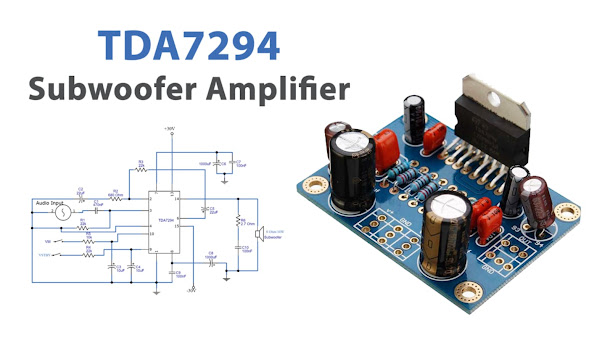Introduction
In this tutorial, we are going to make a “TDA7294 Subwoofer Amplifier
Circuit”. A subwoofer (or sub) is a loudspeaker designed to reproduce
low-pitched(bass and sub-bass) audio frequencies. These frequencies are
lower than those which can be generated by a woofer. The typical
frequency range for a subwoofer is about 20–200 Hz for consumer products
and below 100 Hz for professional live sound. They can never be used
alone, as intended to augment the low-frequency range of loudspeakers
that cover the higher frequency bands. While the term “subwoofer”
technically only refers to the speaker driver.
We need a power amplifier to drive a high-power subwoofer
loudspeaker, then only we can get perfect bass sound from the input
audio signal. Here we design a subwoofer amplifier circuit by using IC
TDA7294 with minimum external components. The IC TDA7294 comes in a
multi-watt package, it can be easily connected with a heat sink. This IC
has thermal shutdown and short-circuits protection. And due to the wide
voltage range and high out current capability, it is able to supply the
highest power into both 4Ω and 8Ω loads. Even in presence of poor
supply regulation, with high supply voltage rejection. The built-in
muting function with turn-on delay simplifies the remote operation
avoiding switching on-off noises. This IC can give up to 100 watts of
output power, you can use a 30V dual power supply (+30V GND -30V) as a
power source.
Introduction
In this tutorial, we are going to make a “TDA7294 Subwoofer Amplifier Circuit”. A subwoofer (or sub) is a loudspeaker designed to reproduce low-pitched(bass and sub-bass) audio frequencies. These frequencies are lower than those which can be generated by a woofer. The typical frequency range for a subwoofer is about 20–200 Hz for consumer products and below 100 Hz for professional live sound. They can never be used alone, as intended to augment the low-frequency range of loudspeakers that cover the higher frequency bands. While the term “subwoofer” technically only refers to the speaker driver.
We need a power amplifier to drive a high-power subwoofer loudspeaker, then only we can get perfect bass sound from the input audio signal. Here we design a subwoofer amplifier circuit by using IC TDA7294 with minimum external components. The IC TDA7294 comes in a multi-watt package, it can be easily connected with a heat sink. This IC has thermal shutdown and short-circuits protection. And due to the wide voltage range and high out current capability, it is able to supply the highest power into both 4Ω and 8Ω loads. Even in presence of poor supply regulation, with high supply voltage rejection. The built-in muting function with turn-on delay simplifies the remote operation avoiding switching on-off noises. This IC can give up to 100 watts of output power, you can use a 30V dual power supply (+30V GND -30V) as a power source.
Circuit Diagram
IC TDA7294- 100W DMOS audio amplifier is a monolithic integrated
circuit, it comes in multiwatt15V and multiwatt15H packages with a mute
option from ST. As IC has mute and stand-by functions to mute the audio
output the pin 10 (Vm) should be less than 1.5V and the mute pin 10 (Vm)
should be greater than 3.5V. The IC has low noise, low distortion, and
good ripple rejection. It can be operated from a wide range of supply
voltages. The typical input resistance of TDA7294 IC is 100KΩ and
quiescent current is approximately 30mA and its maximum value is 65mA.
Working Explanation
IC TDA7294- 100W DMOS audio amplifier is a monolithic integrated circuit, it comes in multiwatt15V and multiwatt15H packages with a mute option from ST. As IC has mute and stand-by functions to mute the audio output the pin 10 (Vm) should be less than 1.5V and the mute pin 10 (Vm) should be greater than 3.5V. The IC has low noise, low distortion, and good ripple rejection. It can be operated from a wide range of supply voltages. The typical input resistance of TDA7294 IC is 100KΩ and quiescent current is approximately 30mA and its maximum value is 65mA.
Working Explanation
Applications
Used in Hi-Fi field applications such as home stereo, self-powered loudspeakers, and top-class TV.
Used in Hi-Fi field applications such as home stereo, self-powered loudspeakers, and top-class TV.




Post a Comment